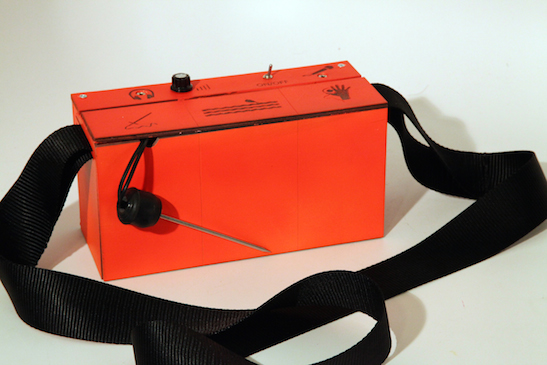SATURDAY, OCTOBER 10TH, 12PM – 4PM
SUNDAY, OCTOBER 11TH, 12PM -4PM
This workshop is for artists and researchers wanting to become more familiar with the potential of sound. Our focus will be on expanding our understanding of sound in an environment. This requires a basic vocabulary for talking about sound as a material, as well as the ability to make and use tools for investigating and manipulating sound for creative purposes. Our frame of reference will be Good Vibrations, a mobile listening kit that allows “acoustic explorers” to find the lesser audible sounds in their environment. By using hand-made microphones and amplifiers, listeners can tune into the subtle vibrations that usually go unnoticed. The project encourages listeners to reimagine their sonic environment by playfully exploring the world through their ears.
The workshop will introduce participants to the world of sound art, while providing techniques for making tools for creating these experiences. This will include the fabrication of hand-made microphones and amplifiers for use in installations, performances, and scientific research. The goal of the workshop is to take these tools into the field and use them for artistic investigation and public engagement.
CONTENT
For the first session, students will be introduced to the sound art practice. Examples of seminal and canonical works will be presented, giving students a taste of potential projects. From there we will move onto describing the basic physics and properties of sound. Our introduction will end with an explanation of how sound is received through a microphone, amplified with an amplifier, and sent through a speaker to produce audible sound. The rest of the workshop will consist of building a contact microphone and an amplifier. From there we will take our tools out into nearby McCarren Park and amplify found sounds.
SESSION 1, 10/10
- Introduction
- Overview of sound art
- Overview of physics of sound
- Overview of how microphone and amplifier work
- Contact microphone build
- Amplifier build on breadboard
SESSION 2, 10/11
- Amplifier build on PCB
- Placing amplifier in enclosure
- Exploring McCarren Park with listening kits
- Presentation of experiments
WHAT YOU WILL BUILD DURING THE WORKSHOP
- One contact mic
- One amplifier
- One custom enclosure with custom pcb
PREREQUISITES
Students do not need to have any electronic experience. Some soldering experience is a plus but is not required. An expertise knowledge of sound and how it works is also not required. A large part of the workshop is to teach that to you! A strong curiosity and willingness to learn about sound is the only basic requirement.
WHAT TO BRING
- Headphones
INSTRUCTOR
Johann Diedrick makes installations, performances, and software that allow people to actively participate in the production of sound. His work has been exhibited internationally in numerous group exhibitions, conferences and festivals, including the New Interfaces for Musical Expression (NIME) conference in Daejeon and Seoul, Korea, the Invisible Places, Sounding Cities conference in Viseu, Portugal, and the Dumbo Arts Festival in Brooklyn, New York. He received his Masters in Professional Studies at the Interactive Telecommunications Program (ITP) at Tisch School of the Arts at New York University, focusing on sound art. During time at ITP he was a researcher at the InterLab at the Yamaguchi Center for Arts and Media (YCAM) in Yamaguchi, Japan. Afterwards he worked as an interactive software developer at Qosmo in Tokyo, Japan. He is currently a software developer at the Metropolitan Museum of Art.
Website: http://www.johanndiedrick.com
Github: @jdiedrick
Twitter: @jdiedrick
Instagram: @johanndiedrick
REGISTRATION
Limited to 8 students
REGISTRATION CLOSED

 Share on Twitter
Share on Twitter Share on Facebook
Share on Facebook